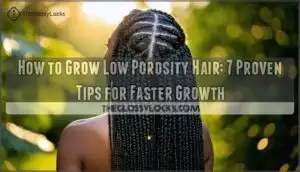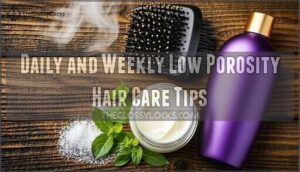This site is supported by our readers. We may earn a commission, at no cost to you, if you purchase through links.

When you’re deep conditioning, adding some heat really helps crack open those tight cuticles so moisture can actually get in there.
You’ll want to clarify about once a week too—all that product buildup basically chokes out your hair follicles.
Stick with lightweight formulas that skip the protein and silicones since they just create more weight your hair doesn’t need.
Focus on gentle handling and protective styling since low porosity hair recovers slowly from damage. The secret lies in strategic moisture penetration rather than surface-level treatments that block growth potential.
Table Of Contents
- Key Takeaways
- What Makes Hair Low Porosity?
- How to Test for Low Porosity Hair
- Best Products for Low Porosity Hair Growth
- Daily and Weekly Low Porosity Hair Care Tips
- Promoting Growth and Preventing Damage
- Frequently Asked Questions (FAQs)
- What can I do to improve the health of my low porosity hair?
- Are there any styling products specifically for low porosity hair?
- How often should I deep condition my low porosity hair?
- How long does low porosity hair take to grow?
- Can you permanently change hair porosity levels naturally?
- Why does low porosity hair break so easily?
- Does weather affect low porosity hair differently?
- Conclusion
Key Takeaways
- You’ll need lightweight, water-based products instead of heavy creams that create buildup on your tightly-closed cuticles and block moisture absorption.
- Use heat during deep conditioning sessions to open stubborn cuticles and allow moisture to actually penetrate your hair shaft for better hydration.
- Clarify your hair weekly to remove product accumulation that suffocates follicles and prevents new growth from reaching its full potential.
- Focus on gentle handling and protective styling since your low porosity hair recovers slowly from damage and needs strategic care rather than aggressive treatments.
What Makes Hair Low Porosity?
Your hair’s structure determines its porosity level, and understanding this helps you choose the right care routine.
Low porosity hair has tightly closed cuticles that resist moisture absorption, making it harder to hydrate but easier to maintain once properly moisturized.
Key Characteristics of Low Porosity Hair
Low porosity hair features tightly sealed cuticles that form a protective barrier around each strand. These flat-lying cuticles make it tough for moisture and products to get inside, leading to buildup on the surface instead of absorption.
This sealed structure explains why your hair takes forever to dry after washing and why it’s hard to get completely soaked in the first place. The tight cuticle pattern creates resistance to both water going in and coming out.
Causes and Genetic Factors
Your hair’s low porosity really comes down to what you inherited from your parents. The way your cuticles formed and how your follicles developed was already decided by your genes.
But here’s the thing—your environment plays a role too. All that heat styling and chemical processing can actually change how porous your hair becomes over time. And don’t forget about the products you use. Heavy formulas love to build up on your strands, creating their own barriers.
- Your genetics determine whether you got the low porosity trait from family
- Tightly packed cuticles naturally resist letting moisture in
- Heat and chemical damage can bump up porosity levels temporarily
- Heavy products create coating that blocks your hair’s natural structure
How to Identify Your Hair Porosity
Determining hair porosity doesn’t require guesswork when you know what to look for. Understanding hair porosity starts with observing how your hair cuticles behave. The classic float test involves dropping a clean strand in water—low porosity hair floats or sinks slowly.
Check your product absorption rate and drying time assessment too. Hair texture analysis reveals porosity visual cues through cuticle examination.
How to Test for Low Porosity Hair
You’ll want to figure out your hair’s porosity level first – it makes all the difference in choosing the right products and techniques.
Three simple tests can tell you if you’re dealing with low porosity hair: the float test, spray bottle test, and slide test.
The Hair Strand Float Test
When testing low porosity hair characteristics, grab a clean hair strand from your brush. Drop it into room temperature water and watch carefully. Low porosity hair floats or sinks slowly, generally due to poor hair moisture absorption.
For test accuracy, make certain of hair cleanliness beforehand and maintain consistent water temperature. Result interpretation becomes clearer when you repeat this float test multiple times.
Spray Bottle and Slide Tests
Beyond the float test, you can quickly check hair porosity using spray and slide techniques. These methods offer visual inspection of how your hair strand reacts to water moisture absorption and cuticle smoothness.
Here are five quick technique variations for test accuracy:
- Water beading test – Spray clean hair; low porosity hair shows water droplets sitting on surface
- Slide test – Run fingers up wet hair strand; smooth feel indicates tightly closed cuticles
- Absorption timing – Watch how long water takes to penetrate; slow absorption signals low porosity hair
- Surface texture – Feel for bumpy versus smooth cuticles during visual inspection
- Multiple strand testing – Test several areas for consistent hair moisture patterns
Interpreting Test Results
Multiple tests give you the clearest picture of your hair porosity. If your hair strand floats in water but products absorb quickly, environmental factors might skew results.
Low porosity hair usually shows consistent patterns: slow water absorption, product buildup on the hair shaft, and tight cuticles.
Test accuracy improves when you repeat methods on clean, product-free strands for reliable expected outcomes.
Best Products for Low Porosity Hair Growth
You’ll find the right products can make all the difference in helping your low porosity hair absorb moisture and grow stronger.
The key is choosing lightweight formulas that won’t sit on top of your hair strands and cause buildup.
Lightweight Oils and Water-Based Products
Water-based moisturizers tap into low porosity hair’s potential through absorption and oil penetration. Lightweight oils like jojoba and argan boost scalp hydration without buildup.
Strategic product layering maximizes ingredient synergy—apply water-based products first, then seal with light oils. Using sulfate-free shampoos is also recommended for cleansing without stripping natural oils.
This combination boosts moisturizing effectiveness and promotes sustained hair growth.
Protein-Free and Silicone-Free Formulas
When you have low porosity hair, protein-free and silicone-free formulas make a real difference. Your hair can actually absorb moisture instead of fighting against heavy ingredients that just sit on top. The payoff goes beyond just better hydration – you’ll notice your hair feels softer and moves more naturally.
Over time, this approach really pays off. Your hair stays flexible instead of getting that stiff, coated feeling. Products actually work because they can penetrate your hair shaft. And your scalp stays cleaner since there’s less gunk building up at the roots.
Here’s the thing about silicones – they form a barrier that blocks moisture from getting where it needs to go. For hair that already struggles to let things in, that’s the last thing you want.
Natural Ingredients That Nourish
Natural ingredients work better than synthetic alternatives for low porosity hair. Honey benefits include attracting moisture deep into tightly-closed cuticles. Citrus extracts help open hair shafts for better absorption. Almond oil and jojoba oil penetrate easier than heavy butters.
Herbal infusions like rosemary boost scalp circulation. Simple DIY recipes combining these Ayurvedic ingredients nourish natural hair effectively.
Daily and Weekly Low Porosity Hair Care Tips
Your daily and weekly routine can make or break your low porosity hair growth goals. You’ll need consistent clarifying treatments to prevent product buildup and strategic deep conditioning with heat to help moisture actually penetrate those stubborn cuticles.
The routine you stick to daily and weekly? It’s everything for low porosity hair growth. Without regular clarifying treatments, products just sit on top of your hair doing nothing.
And that deep conditioning session needs heat—otherwise moisture bounces right off those tight cuticles.
Beyond shampooing regularly, you need strategic clarifying frequency to remove stubborn hair buildup from your hair shaft. Low porosity hair attracts product buildup like a magnet, blocking moisture absorption.
- Use chelating shampoos weekly to strip mineral deposits and residue removal
- Try DIY clarifiers like apple cider vinegar rinses monthly
- Focus on scalp exfoliation during washing sessions
- Switch to sulfate-free shampoo between clarifying treatments to maintain balance
Regular clarifying keeps your cuticles clean for better product penetration.
Deep Conditioning With Heat
Heat unlocks low porosity hair’s potential for deep conditioning. Steam hair treatments or hooded dryers at choice temperatures help mask ingredients penetrate tightly-packed cuticles. Follow frequency guidelines to avoid over-processing while ensuring proper post-treatment care for peak hair hydration.
| Heat Application Methods | Optimal Temperatures |
|---|---|
| Steamer treatments | 100-110°F |
| Hooded dryer sessions | 120-140°F |
| Warm towel wraps | Body temperature |
Protective Styling and Nighttime Care
Your hair’s nighttime routine can make or break your growth goals. Protective hairstyles shield strands from friction reduction while you sleep. Choose these nighttime essentials:
- Silk bonnets – trap moisture and prevent hair breakage
- Satin pillowcase – reduces friction on delicate strands
- Loose braids – maintain protective styles without tension
- Scalp health massages – boost circulation before bed
- Nighttime hydration sprays – seal in moisture overnight
Smart protective styling keeps your low porosity hair thriving.
Promoting Growth and Preventing Damage
You’ll want to focus on three key areas to get the most growth while protecting your low porosity strands from damage.
Smart moisture retention strategies, proper nutrition, and careful handling of heat and chemicals will keep your hair strong and help it reach its full length potential.
The secret to growing healthy low porosity hair comes down to mastering moisture retention, nourishing your strands properly, and being gentle with heat and chemicals.
Get these basics right and you’ll see your hair reach lengths you didn’t think were possible.
Moisturizing low porosity hair requires strategic layering. Start with pre-pooing benefits using lightweight oils before washing.
Apply humectant usage products when hair’s damp, then seal with oil layering techniques. Steam hydration opens cuticles for deeper penetration.
Product sealing locks moisture in your hair care routine, preventing hair breakage and maintaining hair health through proper moisture retention.
Diet, Supplements, and Scalp Care
Your hair growth depends on what you feed your body. A Nutrient-Rich Diet for Hair Growth includes lean proteins, omega-3s from salmon, and iron-rich spinach. A balanced diet is key, providing the necessary nutrients for healthy hair growth.
Scalp massages boost Scalp Circulation, delivering nutrients to follicles. Hydration Importance can’t be overstated—drink two liters daily.
Consider Supplement Choices like biotin or zinc if your Vitamin Intake falls short for peak hair health.
Trimming, Heat Use, and Chemical Processing
Strategic trimming every 8-12 weeks prevents split ends from traveling up your hair shaft. Low porosity hair needs careful heat damage prevention and limited chemical processing to maintain protein balance.
- Trim Frequency: Schedule cuts every 8-12 weeks to remove damaged ends
- Heat Damage: Use heat protectant and limit styling to twice weekly at most
- Chemical Effects: Space treatments 6-8 weeks apart to prevent over-processing
- Protein Balance: Avoid excessive coloring that disrupts hair health
- Color Caution: Deep condition before and after chemical treatments
Frequently Asked Questions (FAQs)
What can I do to improve the health of my low porosity hair?
Use lightweight oils like argan or almond oil to penetrate tight cuticles. Apply clarifying treatments weekly to prevent buildup. Choose water-based products over heavy creams for better absorption.
Are there any styling products specifically for low porosity hair?
Yes, you’ll want lightweight water-based products that won’t sit on your strands. Look for protein-free leave-in conditioners, light oils like argan or almond, and clarifying shampoos to prevent buildup.
How often should I deep condition my low porosity hair?
Deep condition your low porosity hair once weekly. This frequency prevents product buildup while ensuring adequate moisture penetration. Your tightly packed cuticles need consistent but not excessive conditioning.
How long does low porosity hair take to grow?
Low porosity hair grows at the same rate as other hair types—about half an inch monthly.
However, it appears to grow slower because breakage and dryness make retaining length challenging without proper care.
Can you permanently change hair porosity levels naturally?
Hair porosity is largely genetic and can’t be permanently changed naturally. Chemical treatments like bleaching increase porosity, but there’s no natural method to permanently alter your hair’s structure.
Why does low porosity hair break so easily?
It’s like walking on eggshells with your strands. Your hair’s tight cuticles create a moisture barrier, leaving strands dehydrated and brittle.
Low porosity hair’s tight cuticles create moisture barriers, leaving strands dehydrated and prone to breakage
Without proper hydration, your hair lacks elasticity and snaps under tension.
Does weather affect low porosity hair differently?
Yes, weather impacts your low porosity hair uniquely. High humidity can cause low porosity hair to become frizzy, while moisture in the air can weigh down your strands, causing your hair to go flat.
Conclusion
Mastering how to grow low porosity hair is like unlocking a treasure chest with the right key. You’ve learned that lightweight products, heat-assisted deep conditioning, and weekly clarifying create the perfect growth environment.
Your tightly-closed cuticles need strategic moisture penetration rather than heavy creams. Remember to handle your strands gently and maintain consistent protective styling.
Growing low porosity hair takes the right approach, and you’ve figured out what works. Lightweight products paired with heat-assisted deep conditioning make all the difference. Weekly clarifying keeps buildup from blocking your cuticles.
Those tightly-closed cuticles of yours need smart moisture tactics, not heavy creams that just sit on top. Gentle handling and consistent protective styles will get you there.
Stick with these methods and you’ll start seeing stronger, longer hair that shows off all your hard work with proper low porosity care.
- https://gramercyhairsalon.com/caring-for-low-porosity-hair/
- https://hairlove.com/blogs/hairlove/hair-porosity-101-understanding-your-hairs-absorption-and-retention-power
- https://www.rupahealth.com/post/what-is-low-porosity-hair
- https://www.halohaircare.co.nz/blogs/news/hair-porosity-the-truth-about-hair-porosity
- https://yuaiahaircare.com/blogs/news/guide-for-low-porosity-hair










